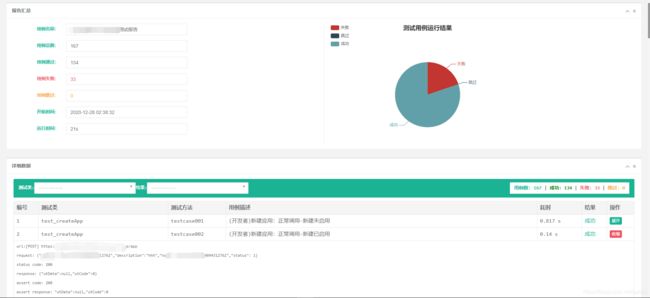接口自动化:Python+unittest+excel+BeautifulReport使用关键字驱动实现脚本和用例执行数据完全分离
1.前言
项目接口较多,测试场景多,版本更新影响范围广,为了能及时对改动影响的所有模块遍历测试场景,故开发此新版接口自动化。为了易于维护,选择了python+unittest+excel模式,当前版本只需在excel测试文件中进行模块、用例的增删改,实现了脚本和用例完全脱离。
环境:Python、Unittest、BeautifulReport、Excel
- BeautifulReport模块做了自定义修改,生成的html报告中用例描述由原先的函数描述改为测试执行函数中的title变量,请直接将文件夹BeautifulReport粘贴至X:\Python36\Lib\site-packages文件夹下
2.文件结构介绍
common
base_assert.py:断言,目前仅支持assertEqual和assertIn,后续根据需要维护添加
read_ini.py:读取config.ini中的固定配置项如域名、token
log.py:日志,支持debug、info、warning、error、critical日志
read_excel.py:读取excel测试用例并初始化,包括用例中的关键字替换
base_run.py:单用例执行方法,setup函数、teardown函数、testcase函数
request_func.py:封装request方法,目前支持POST、GET,后续可根据需要维护添加
trans_json.py:封装处理字典json转换
config
config.ini:域名配置、token配置
file_path.py:所有需要传入的文件地址
log
log.log:所有日志信息
error.log:报错日志信息
report
xxxx.html:报告html
run.py:执行用例集
test_case_data.xlsx:测试用例
3.测试用例参数
test_case_data.xlsx
|
用例参数
|
枚举
|
解释说明 |
|---|---|---|
| case_id | testcase001 | 测试用例编号,同时也是测试类名 |
| case_module | test_createApp | 测试用例接口模块,同时也是测试执行函数名称,必须以test开头 |
| case_name | (开发者)新建应用:正常调用 | 测试用例描述 |
| username | usernamex,/,空 | 用户名,需要切换账号时填入,如果使用上次登录的账号则使用"/",如果不需要登录直接为空 |
| password | passwordx,/,空 | 密码,同用户名一致 |
| method | POST,GET | 接口类型,暂时仅支持post、get |
| url_path | /user2/xxx/xxx | 接口url地址 |
| api_type | web,oauth | 接口网关类型,web接口则使用web网关的域名,如果是oauth则使用oauth域名 |
| headers | {},空 | 接口请求头,如果需要指定则填上,如果不需要则传入{}空括号,如果是公共接口则为空 |
| request_body | {“xx”:“xx_ |
有入参则输入,没有为空,目前支持 |
| status_code | 200 | 预期状态码 |
| resp_expect | “xx”:“xx” | 预期返回结果,只要包含返回结果的关键字部分即可 |
| save_data | userUid | 返回参数中期望保存的字段存入字典,当前仅支持一级结构的key,如果希望保存二级结构的key需要另外处理,另外如果想保存多个参数也需要优化脚本 |
| use_data | testcaseXXuserUid | 使用关联的标识,由用例编号+字段组成,当读取到标识存在时会把入参中的关键字替换为字典中暂存的值,目前只支持单参数处理,后续优化为多参数 |
注意:测试用例读取逻辑为一次性所有读取后批量处理需要替换的参数,如果多条用例都使用了
4.关键代码
read_ini.py
def read_inifile():
# 读取配置
try:
config = configparser.ConfigParser()
config.read(file_path.config_file)
except Exception as e:
MyLog.error('\033[31m {} \033[0m'.format(e))
raise
return config
class GetIni:
def __init__(self, inikey, inivalue, newvalue=None):
# 初始化配置
self.inikey = inikey
self.inivalue = inivalue
self.newvalue = newvalue
self.config = read_inifile()
def get_ini(self):
# 返回配置文件的某项参数值
try:
convalues = self.config.get(self.inikey, self.inivalue)
except Exception as e:
MyLog.error('\033[31m {} \033[0m'.format(e))
raise
return convalues
def write_ini(self):
# 修改配置文件的某项参数值
try:
self.config.set(self.inikey, self.inivalue, self.newvalue)
self.config.write(open(file_path.config_file, 'w'))
except Exception as e:
MyLog.error('\033[31m {} \033[0m'.format(e))
raise
read_excel.py
def read_xlrd(excel_file):
'''读取excel所有数据'''
try:
data=xlrd.open_workbook(excel_file)
# 获取所有sheet名
sheets=data.sheet_names()
datafile=[]
now=int(round(time.time() * 1000))
for sheet in sheets:
#遍历所有sheet的数据
table=data.sheet_by_name(sheet)
for rowNum in range(table.nrows):
#去掉表头,替换时间戳标志
if rowNum>0:
rowdata=table.row_values(rowNum)
rowData=[str(i).replace('' ,str(now)) for i in rowdata]
datafile.append(rowData)
except Exception as e:
MyLog.error('\033[31m {} \033[0m'.format(e))
raise
return datafile
class InitData():
'''初始化excel数据'''
def __init__(self,datafile,case_no):
#case_no用例编号索引
#datafile所有用例数据
self.datafile=datafile
self.case_id=[]
self.case_module=[]
self.case_name=[]
self.username=[]
self.password=[]
self.method=[]
self.url_path=[]
self.api_type=[]
self.headers=[]
self.request_body=[]
self.status_code=[]
self.resp_expect=[]
self.resp_current=[]
self.case_no=case_no
def get_data(self):
#获取某条用例的所有字段值
self.case_id=self.datafile[self.case_no][0]
self.case_module=self.datafile[self.case_no][1]
self.case_name=self.datafile[self.case_no][2]
self.username=self.datafile[self.case_no][3]
self.password=self.datafile[self.case_no][4]
self.method=self.datafile[self.case_no][5]
self.url_path=self.datafile[self.case_no][6]
self.api_type=self.datafile[self.case_no][7]
self.headers=self.datafile[self.case_no][8]
self.request_body=self.datafile[self.case_no][9]
self.status_code=self.datafile[self.case_no][10]
self.resp_expect=self.datafile[self.case_no][11]
self.resp_current=self.datafile[self.case_no][12]
request_func.py
def set_headers(headers, token_type, access_token):
# 设置header
try:
if headers != '' and 'Authorization' not in headers:
# headers转换成dict,添加token,url拼接
headers = trans_json.json_loads(headers)
headers['Authorization'] = token_type+' '+access_token
except Exception as e:
MyLog.error('\033[31m {} \033[0m'.format(e))
raise
return headers
def set_urls(api_type, url):
# 拼接完整url
try:
login_url = GetIni('login_url', 'login_url').get_ini()
http_url = GetIni('http_url', 'http_url').get_ini()
if api_type == 'oauth':
#果是oauth接口,拼接oauth域名
url = login_url+url
else:
#拼接web域名
url = http_url+url
except Exception as e:
MyLog.error('\033[31m {} \033[0m'.format(e))
raise
return url
def print_log(method, url, params):
# 打印请求方法、url、入参至报告和log
print('url:[{}] {}'.format(method, url))
print('request: {}'.format(params))
MyLog.info('url:[{}] {}'.format(method, url))
MyLog.info('request: {}'.format(params))
def request_post(url, headers, params, api_type):
# post方法
try:
token_type = GetIni('http_token', 'token_type').get_ini()
access_token = GetIni('http_token', 'access_token').get_ini()
url = set_urls(api_type, url)
print_log('POST', url, params)
headers = set_headers(headers, token_type, access_token)
response = requests.post(url=url, headers=headers, data=params)
except Exception as e:
MyLog.error('\033[31m {} \033[0m'.format(e))
raise
return response
base_run.py
def setup(self):
# 每个用例执行前调用,判断是否需要登录新账号
try:
if self.data.username and self.data.username != '/':
# 用例需要切换账号登录时,获取用户名密码登录,返回token写入config.ini
param = {
'username': self.data.username,
'password': self.data.password,
'grant_type': 'password',
'scope': 'read'
}
# 获取配置中的登录token
login_token = GetIni('login_token', 'Authorization').get_ini()
# 获取登录url
login = GetIni('login_url', 'login').get_ini()
# 登录headers
headers = {
'Content-Type': 'application/x-www-form-urlencoded',
'Authorization': login_token}
# 登录requests
response = request_func.request_post(
login, headers, param, 'oauth')
# 返参json解析
response_data = trans_json.json_loads(response.text)
# 新用户token写入配置
GetIni('http_token', 'access_token',
response_data['access_token']).write_ini()
else:
pass
except Exception as e:
MyLog.error('\033[31m {} \033[0m'.format(e))
raise
def teardown(self):
pass
def test_case(self):
# 主体测试函数
try:
MyLog.info('------[正在执行:{}]------'.format(self.data.case_id))
if self.data.method == 'POST':
# post请求
res = request_func.request_post(
self.data.url_path, self.data.headers, self.data.request_body, self.data.api_type)
elif self.data.method == 'GET':
# get请求
res = request_func.request_get(
self.data.url_path, self.data.headers, self.data.api_type, self.data.request_body)
# 打印信息至报告
print_report(res.status_code, res.text, int(
float(self.data.status_code)), self.data.resp_expect)
except Exception as e:
MyLog.error('\033[31m {} \033[0m'.format(e))
raise
assertion = Assertions()
assertion.assert_code(self.data.case_id, res.status_code,
int(float(self.data.status_code)))
assertion.assert_in_text(
self.data.case_id, res.text, self.data.resp_expect)
MyLog.info('执行成功')
def print_report(status_code, text, assert_code, resp_expect):
# 打印code,response,expectcode,expectres
print('status code: {}'.format(status_code))
print('response: {}'.format(text))
print('assert code: {}'.format(assert_code))
print('assert response: {}'.format(resp_expect))
run.py创建测试用例集,程序入口文件
if __name__ == "__main__":
# 读取测试用例
datafile = read_excel.read_xlrd(file_path.test_data)
case_numbers = len(datafile)
# 获取当前时间
now = time.strftime('%Y-%m-%d %H_%M_%S')
# 定义报告存放路径
filename = file_path.report_file+now+'result.html'
# 创建unittest套件
testsuit = unittest.TestSuite()
with open(filename, 'wb') as fp:
# 遍历所有用例
MyLog.info('************开始测试************')
for case_num in range(case_numbers):
data = InitData(datafile, case_num)
data.get_data()
# 创建测试类,data.case_module类名,data用例数据,title用例描述,setUp设置为setup函数,每条用例之前前调用,tearDown用例执行后调用,data.case_id测试用例执行函数
newTestCase = type(data.case_module, (unittest.TestCase,), {
'data': data, 'title': data.case_name, 'tearDown': base_run.teardown, 'setUp': base_run.setup, data.case_id: base_run.test_case},)
# 测试类加入unittest套件
testsuit.addTest(unittest.TestLoader(
).loadTestsFromTestCase(newTestCase))
#定义测试报告
run = BeautifulReport(testsuit)
run.report(filename=filename, description='xxxx测试报告')
MyLog.info('************完成测试************')
5.生成测试报告
6.日志文件
log.log
2020-12-21 02:41:59,344 - INFO - ------[正在执行:testcase004]------
2020-12-21 02:41:59,348 - INFO - url:[POST] https://xxxx/xxxxx/xxx/app
2020-12-21 02:41:59,349 - INFO - request: {
"xxxxx":"xxxxx","description":"hhh","name": "xxxx"}
2020-12-21 02:41:59,466 - INFO - assert code--Success , status_code:[200] == expected_code: [200]
2020-12-21 02:41:59,467 - INFO - assert response--Success ,expected_msg: [{
"utData":null,"utCode":0}] in body: [{
"utData":null,"utCode":0}]
2020-12-21 02:41:59,468 - INFO - 执行成功
7.后续优化
- 改进接口之间的数据关联
- 断言处理的不够灵活
- 报告没有很好的模块划分
- 添加邮件发送功能
- 集成Jenkins定时任务
